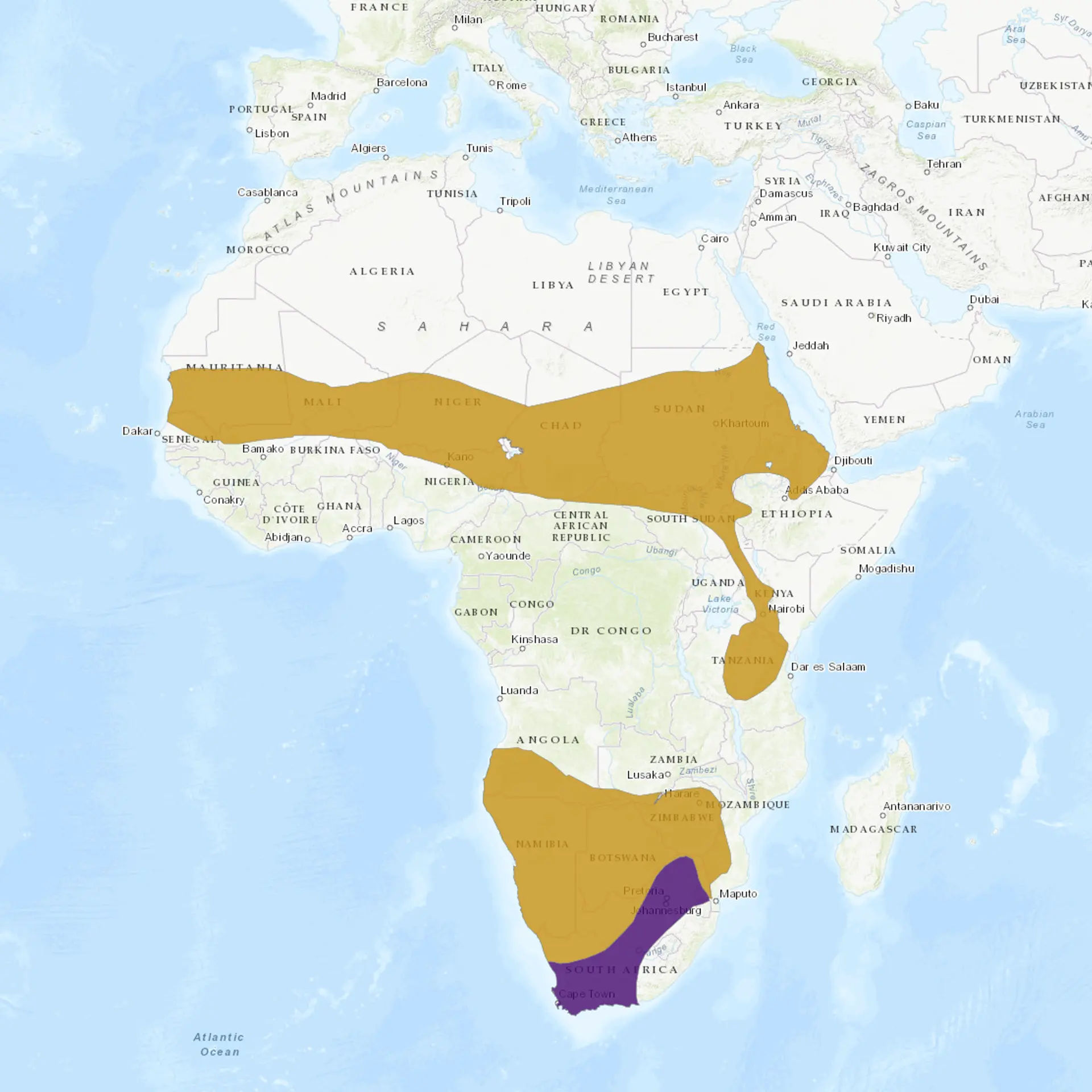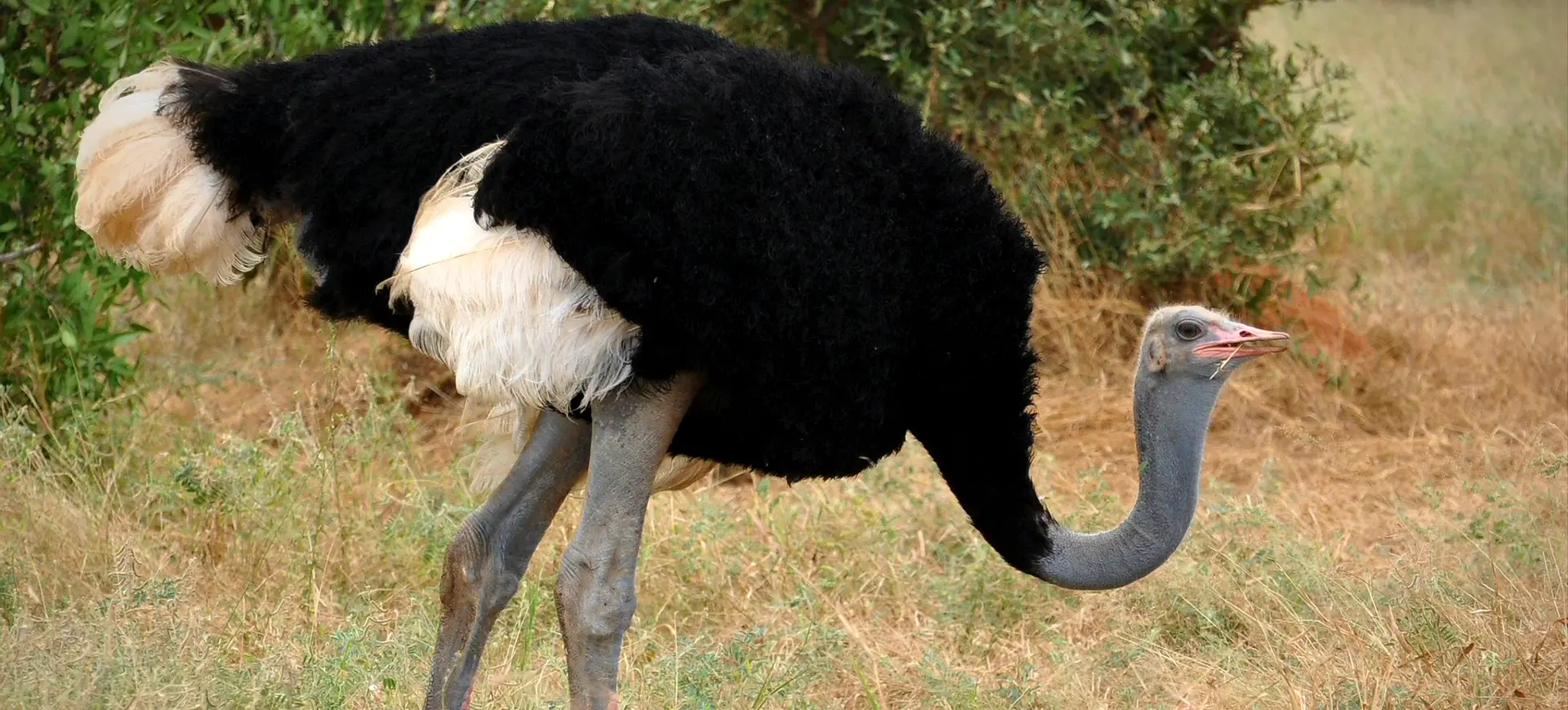Overview
The Common Ostrich (Struthio camelus) is a distinct and fascinating creature, the world’s largest and heaviest bird species. Though flightless, it is renowned for its impressive speed, capable of outrunning many predators. Native to the savannas and grasslands of Africa, ostriches are unmistakable in their appearance, with their long necks, large bodies, and strong, elongated legs.
The ostrich’s physical attributes are adaptations to their environment and lifestyle. Being flightless, they’ve evolved into fleet-footed runners, their strong legs enabling them to sprint at incredible speeds while their acute vision allows them to spot threats from a distance. Their long necks, while often thought to bury in the sand, actually increase their field of vision and reach low vegetation.
Unfortunately, despite their remarkable adaptations and lack of natural predators, ostrich populations face challenges due to habitat loss and hunting. Their feathers, meat, and eggs are highly valued, which has led to commercial farming. Conservation efforts are being made to ensure the species’ survival and limit its exploitation in the wild.
Taxonomy
Kingdom
Phylum
Class
Order
Family
Genus
Species
Type
Current distribution:
Common Ostriches are widely distributed across the African continent. Their range includes parts of Eastern Africa, from Ethiopia and Kenya south to Tanzania, as well as Southern Africa in Namibia, Botswana, Zimbabwe, and South Africa. They are also found in the Sahel and Sahara deserts in the north.
Over time, the range of the ostrich has reduced due to hunting and habitat loss caused by agricultural expansion. Some populations now exist mostly in protected areas like national parks and reserves.
Physical Description:
The Common Ostrich is an iconic bird with a distinct appearance. Males are characterized by black plumage with white wing tips and tail feathers, while females and young ostriches bear a more subdued, grey-brown coloration. Their neck and legs are largely featherless, revealing light pink or grey skin. The bird’s large body is balanced on two muscular legs, each ending in two toes – a unique trait among birds.
Ostriches are notable for their size; adult males can stand up to 9 feet (2.75 meters) tall and weigh as much as 320 pounds (145 kg), while females are slightly smaller, usually weighing between 220 and 300 pounds (100-136 kg) and standing 5.7 to 6.2 feet tall (1.7-1.9 meters). Their eyes, around 2 inches (5 cm) in diameter, are among the largest of any terrestrial animal, affording them excellent eyesight to spot threats.

Lifespan: Wild: ~40 years || Captivity: ~50 years

Weight: Male: 156 - 320 lbs (71 -145 kg) || Female: 220 - 300 lbs (100 -136 kg)

Height: Male: up to 9 ft (2.75 m) || Female: 5.7 - 6.2 ft (1.7 - 1.9 m)

Wingspan: Up to 6.6 ft (2 m)

Top Speed: 43 mph (70 km/h)
Characteristic:
Native Habitat:
The Common Ostrich is native to Africa, primarily inhabiting the open savannas and semi-arid regions. They favor areas with short vegetation where they can capitalize on their great speed and vision to evade predators. Ostriches can also be found in desert and semi-desert regions, demonstrating their adaptability to harsh conditions.
Their preference for open areas with low vegetation is key to their survival strategy. It impacts their feeding habits, as they mainly feed on available plant matter and small creatures in these environments.
Biomes:
Biogeographical Realms:
Continents:
Countries:
Diet:
Diet & Feeding Habits:
Ostriches are omnivores, primarily feeding on plants, seeds, shrubs, and tree leaves. They also consume insects, small invertebrates, and occasionally small rodents and lizards. A significant part of their diet comprises stones and pebbles, which help grind down food in their gizzard, a specialized part of their stomach.
Despite their large size, ostriches do not need to drink water daily, as they receive most of the hydration they need from the plants they consume. However, if they come across a water source, they drink and may even bathe in it.
Mating Behavior:
Mating Description:
The ostrich has a complex mating system. During the breeding season, males dance to attract females, spreading their wings and swaying from side to side. They also establish territories, which they defend vigorously against other males.
A dominant male usually mates with the dominant female, who then becomes the ‘major’ hen. The major hen lays eggs in a communal nest—a simple pit scraped into the ground by the male—followed by several other ‘minor’ hens. Interestingly, the major hen’s eggs are given a prime position in the middle of the nest and are most likely to be incubated successfully.
Reproduction Season:
Birth Type:
Pregnancy Duration:
Female Name:
Male Name:
Baby Name:
Social Structure Description:
Ostriches exhibit a nomadic lifestyle, forming groups ranging from as few as five to as many as fifty individuals. These groups frequently share their roaming territories with other grazing animals, such as zebras or antelopes, which contributes to a mutually beneficial environment, with each species alert for potential threats.
As the dry season sets in, ostrich social structures change. The groups often disband, with individuals venturing out solo or in pairs. Furthermore, during the breeding season, male ostriches display territorial behavior. The dominant male within the group attracts multiple females to his designated territory, creating a small harem for reproduction.
Groups:
Conservation Status:
Population Trend:
The overall population of Common Ostriches is stable, and they are not currently considered a threatened species. However, the different subspecies have varying levels of risk. For example, the Arabian Ostrich (Struthio camelus syriacus) is extinct, and the North African or Red-necked Ostrich (Struthio camelus camelus) is critically endangered due to hunting and habitat loss.
The majority of ostriches now live in protected areas or on commercial farms. Farming ostriches for their meat, feathers, and eggs is a significant industry in some parts of Africa, particularly South Africa.
Population Threats:
Agricultural expansion and developmental projects significantly contribute to habitat loss, posing a primary threat to the survival of wild ostrich populations. These human activities result in shrinking their natural habitats, impacting their ability to find food, breed, and effectively evade predators. Additionally, ostriches face the threat of hunting for their meat, feathers, and eggs in the wild and commercial farming setups.
Commercial farming of ostriches presents a dual-edged sword. On the one hand, it reduces hunting pressure on wild populations by meeting the demand for ostrich products. On the other hand, it poses a risk of genetic pollution. This can occur when farm-bred ostriches escape their enclosures and interbreed with their wild counterparts, potentially compromising wild populations’ genetic integrity and adaptability.
Conservation Efforts:
Conservation efforts for the Common Ostrich mostly revolve around habitat preservation and regulation of hunting. Protected areas like national parks and reserves are critical for survival. Ostrich farming practices are also regulated to prevent potential negative impacts on wild populations.
Education and awareness initiatives are also integral to ostrich conservation, helping to reduce hunting pressure and ensure sustainable practices within the ostrich farming industry.
Additional Resources:
Fun Facts
- The Common Ostrich is the world’s largest and heaviest bird.
- Despite being flightless, ostriches are excellent runners, reaching up to 43 mph speeds.
- An ostrich’s eye is bigger than its brain and is the largest eye of any bird species.
- Ostriches don’t bury their heads in the sand; this is a common myth. They lay their heads flat on the ground to avoid detection when threatened.
- An ostrich’s kick is powerful enough to kill a lion.
- Ostrich eggs are the largest of any living bird, weighing as much as 3 pounds.
- Ostriches can live without water for days, getting most of their water from the plants they eat.
- Their long legs and neck help them to keep a lookout for predators, such as lions and leopards.
- Each ostrich’s foot has two toes, unlike most birds with three or four.
- A group of ostriches is known as a flock.










